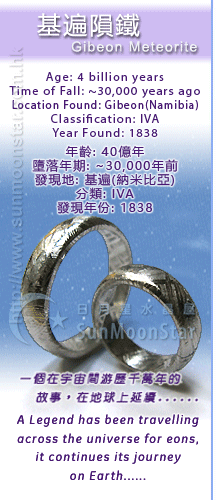| Classification
of Meteorites |
| 1. |
Iron
Meteorites |
|
| |
Iron
meteorites are composed of iron and nickel and
are extremely dense. They are pieces of the cores of asteroids.
Early in Solar System history, asteroids melted and the
dense iron-nickel metal sank to the center to form a core
- much like the Earth has a core.
One of the most distinguishing features of meteorites
is the presence of the Widmanstatten pattern - the distinctive
series of bands in geometric patterns. This pattern is
created by the intergrowth of two different iron-nickel
minerals formed during very slow cooling (a few degrees
every million years) in the core of the asteroid. The
presence of nickel is a universal feature of iron meteorites.
Iron meteorites are subdivided into classes both by chemical
composition and structure. Structural classes are determined
by studying their 2 component iron-nickel alloys: Kamacite
and Taenite. |
|
| |
1.1 Kamacite |
|
| |
Kamacite
is an alloy of iron and nickel, the proportion iron:nickel is beteween 90:10 to 95:5; small quantities of other elements, such as cobalt or
carbon may also be present.
It is a major constituent of iron
meteorites (octahedrite
and hexahedrite
types).
In the octahedrites
it is found in bands interleaving with taenite
forming Widmanstatten
patterns.
In hexahedrites,
fine parallel lines called Neumann
lines are often seen, which are evidence for structural
deformation of adjacent kamacite plates due to shock from
impacts.
Hardness: around 4 |
|
| |
1.1.1
Gibeon
Meteorites
 |
The Giben
Meteorite is a fine octahedrite iron meteorite which flamed
into our atmosphere as a visible star-like streak an estimated
30,000 years ago, landing in what is present day Namibia.
Prior to this, the Gibeon meteorite traveled through space
for over 4 billion years before it was finally trapped
by the Earth's gravitational field and pulled to earth
as a fire ball. |
|
Location Found
|
Classification

|
Age

|
Year Found

|
Rough

|
After Polished

|
|
| Gibeon (Namibia) |
Kamacite
Fine Octahedrite
(IVA) |
4 billion years
Time of Fall: ~ 30,000 years ago
|
1838 |
|
|
 |
| |
1.1.2
Muonionalusta
Meteorite
 |
The Muonionalusta is a meteorite classified as fine octahedrite, type IVA (Of) which impacted in northern Scandinavia, west of the border between Sweden and Finland, about one million years BCE. |
|
Location
|
Classification
|
Age
|
Year Found
|
Rough
|
After Polished
|
|
| Norrbotten (Sweden) |
Kamacite
Fine Octahedrite
(IVA) |
4 billion years
Time of Fall: about one millions years BCE.
|
1906 |
|
|
 |
| |
1.1.3
Sikhote-Alin Meteorite
 |
A conical meteorite fell in a corn field near the village of Bogga Dingare after a bright fireball was witnessed moving west to east and an explosion was heard. The local people hammered the meteorite into many pieces, and most of the material was dispersed. |
|
Location
|
Type
|
Age
|
Year Found
|
Rough
|
After Polished
|
|
Sikhote-Alin Mountains, Maritime Province, Russia |
Kamacite
coarse octahedrite (IIAB) |
4.5 Billion years
Time of Fall: 1947, February 12 |
1956 |
|
|
 |
| |
1.1.4
Agoudal Iron Meteorite |
Also Known As: Imilchil. In 2000 two small pieces of "iron" were collected in the Agoudal area, High Atlas Mountains, Morocco. Later in September 2011, one piece was sold to a dealer who recognized it as an iron meteorite. Since then many more pieces have been collected. Type IIAB iron meteorites are also called hexahedrites. Hexahedrites are low nickel iron meteorites.
|
|
Location
|
Type
|
Age
|
Year Found
|
Rough
|
After Polished
|
|
Centre-South, Morocco |
Iron
Hexahedrite
(IIAB) |
4 billion years
Time of Fall: 40,000 years ago |
2000 |
|
|
|
| |
1.2 Taenite |
|
| |
Taenite
(Fe,Ni) is a mineral found naturally on Earth mostly in
iron meteorites. It is an alloy of iron and nickel, with
nickel proportions of 20% up to 65%. Taenite is a major
constituent of iron
meteorites.
In octahedrites
it is found in bands interleaving with kamacite
forming Widmanstatten
patterns
Hardness: 5 -5.5 |
|
| |
Name |
Location |
Classification |
Age |
Year Found |
Rough |
After Polished |
|
| |
1.2.1
Campo del Cielo Meteorites
 |
Argentina |
Taenite
Coarse Octahedrite
(IAB)
|
4.5 billion years
Time of Fall: between 4,000-6,000 years ago |
1576 |
|
|
 |
| |
1.2.2
Henbury Meteorites |
west-southwest of Henbury, Northern Territory, central Australia |
Taenite
medium octahedrite
(IIIAB) |
4.56 billion years
Time of Fall: 4,700 years ago |
1931 |
|
|
|
| |
1.2.3
Canyon Diablo Meteorites |
Arizona |
Taenite
coarse octahedrite
(IA) |
between 4.53 to 4.58 billion years
Time of Fall: 49,000 years ago |
1891 |
|
|
|
| 2. |
Stony
Meteorites
|
|
| |
More
than 95% of meteorites observed to fall to Earth are stony.
They can be divided into chondrites and achondrites.
Both
types are composed mostly of silicate minerals, but the
great majority also contain metallic iron in small-scattered
grains. |
|
| |
2.1 Chondrites |
| |
Chondrites are named for their most prominent feature -
millimeter-sized spherical bodies called chondrules. These
chondrules (from the Greek for small sphere) formed 4.5
billion years ago in the Solar Nebula - the cloud of gas
and dust from which the Sun, planets, asteroids, and comets
formed. |
|
| |
2.1.1
NWA
869
 |
These meteorites are found in the middle of the desert near no post office! So a numbering system used by the Meteoritical Society (An non-profit organization founded in 1933 by American) incorporates the order of recovery for specimens and their GPS locations. |
|
| Location |
Classification |
Age |
Year
Found |
Rough |
After
Polished |
|
| Northwest
Africa |
Chondrites
(L4-6) |
4.55 billion years
|
2000 |
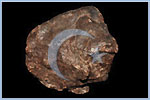 |
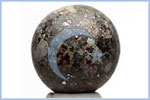 |
 |
| |
2.1.2
Gujba Meteorite |
Location
|
Classification
|
Age
|
Year Found
|
Rough
|
After Polished
|
|
| Bogga Dingare, Yobe State, Nigeria |
Chondrites
bencubbinite (class CBa)
|
4.56 billion years
|
1984 |
|
|
|
| |
2.1.3
Chelyabinsk Meteorite
 |
The Chelyabinsk meteorite (Russian: Челябинский метеорит) is the fragmented remains of the large Chelyabinsk meteor of 15 February 2013 which reached the ground after the meteor's passage through the atmosphere. The descent of the meteor, visible as a brilliant superbolide in the morning sky, caused a series of shock waves that shattered windows, damaged approximately 7,200 buildings and left 1,500 people injured. The resulting fragments were scattered over a wide area. |
|
| Location |
Classification |
Age |
Year
Found |
Rough |
After
Polished |
|
| Lake Chebarkul, Chelyabinsk Oblast, Russia |
Chondrites
(LL5) |
4.55 billion years
Time of Fall:
15 February 2013 |
27 February 2013 |
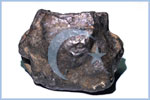 |
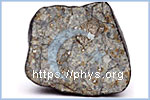 |
 |
| |
2.2 Achondrites |
| |
Less
common, comprising only a few percent of all meteorites,
are achondrites. These are also stony
meteorites composed primarily of silicates, but these
meteorites have experienced familiar geologic processes
of melting and differentiation - although these happened
long ago. Most achondrites formed on asteroids during
the birth of the Solar System, but a small number formed
on Mars and the Moon. |
|
| |
2.2.1
NWA
4664 |
Location |
Classification |
Age |
Year
Found |
Rough |
After
Polished |
|
| Algeria, Northwest
Africa |
Achondrites
(diogenite, polymict breccia) |
over 4 billion years |
2006 |
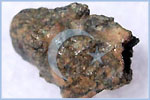 |
 |
|
| |
2.2.2
Johnstown |
Colorado, United States |
Achondrite
(a calcium-poor diogenite) |
4.43 - 4.55
billion years |
1924 |
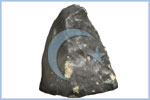 |
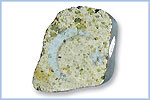 |
|
| 3. |
Stony-iron meteorites |
|
| |
Stony-iron
meteorites, contain about equal proportions of metal and
silicate material, and are rare (less than 2% of all known
meteorites). Stony-iron meteorites form in places where
metal and silicate are mixed. They are divided into two groups: the pallasites and the mesosiderites |
|
| |
3.1 Pallasites |
|
| |
One
type of stony-iron are pallasites - rocks composed of
a network of iron-nickel metal surrounding a greenish,
silicate mineral called olivine. Pallasites probably form
when the olivine-rich mantle of an asteroid mixes with
the metallic core. |
|
| |
3.1.1
Seymchan
 |
Location |
Classification |
Age |
Year
Found |
Rough |
After
Polished |
|
| Magadan Oblast, Russia |
Pallasite
Coarse octahedrite
(IIE) |
over 4 billion years |
1967 |
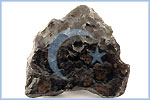 |
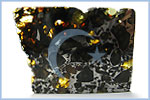 |
 |
| |
3.1.2
Brahin |
Belarus, Russia |
Pallasite
Medium octahedrite |
4.5 billion years |
1807 |
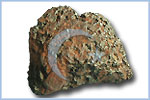 |
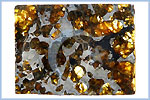 |
|
| |
3.1.3
Imilac
|
Atacama
Desert (Chile) |
Pallasite |
4.5 billion years |
1822 |
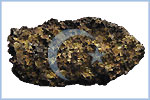 |
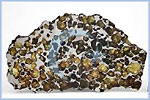 |
|
| |
3.14
Sericho

|
(Habaswein),North-Eastern, Kenya |
Pallasite |
4.5 billion years |
2016 |
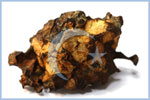 |
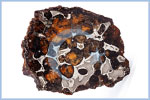 |
 |
| |
3.2 Mesosiderites |
|
| |
Mesosiderites are mixtures of iron-nickel metal and basalt
and probably formed by the collision of two asteroids. |
|
| |
|
Location |
Type |
Age |
Year
Found |
Rough |
After
Polished |
|
| |
3.2.1
Vaca Muerta |
Atacama
Desert, (Chile) |
Mesosiderite
(AI) |
over 4 billion years |
1861 |
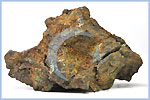 |
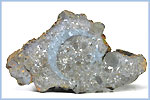 |
|
| |
3.2.2
NWA 2932 |
Northwest Africa (Morocco) |
Mesosiderite |
over 4 billion years |
2005 |
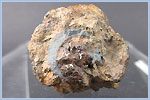 |
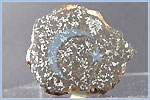 |
|
References: [1] Meteoritical Bulletin 106 (2018) Meteoritics & Planet. Sci, 53, in prep. [2] https://www.lpi.usra.edu/meteor/metbull.php?code=65717; https://www.hou.usra.edu/meetings/lpsc2018/pdf/1556.pdf; http://geology.com; http://www.mindat.org; http://www.meteorites.com.au; 